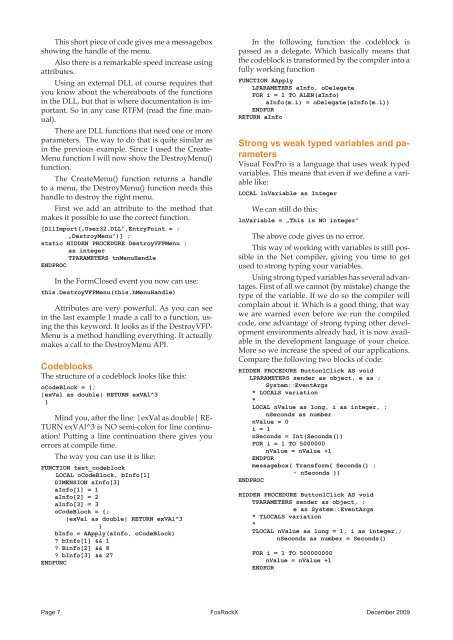Create successful ePaper yourself
Turn your PDF publications into a flip-book with our unique Google optimized e-Paper software.
This short piece of code gives me a messagebox<br />
showing the handle of the menu.<br />
Also there is a remarkable speed increase using<br />
attributes.<br />
Using an external DLL of course requires that<br />
you know about the whereabouts of the functions<br />
in the DLL, but that is where documentation is important.<br />
So in any case RTFM (read the fine manual).<br />
There are DLL functions that need one or more<br />
parameters. The way to do that is quite similar as<br />
in the previous example. Since I used the Create-<br />
Menu function I will now show the DestroyMenu()<br />
function.<br />
The CreateMenu() function returns a handle<br />
to a menu, the DestroyMenu() function needs this<br />
handle to destroy the right menu.<br />
First we add an attribute to the method that<br />
makes it possible to use the correct function.<br />
[DllImport(„User32.DLL“,EntryPoint = ;<br />
„DestroyMenu“)] ;<br />
static HIDDEN PROCEDURE DestroyVFPMenu ;<br />
as integer<br />
TPARAMETERS tnMenuHandle<br />
ENDPROC<br />
In the FormClosed event you now can use:<br />
this.DestroyVFPMenu(this.hMenuHandle)<br />
Attributes are very powerful. As you can see<br />
in the last example I made a call to a function, using<br />
the this keyword. It looks as if the DestroyVFP-<br />
Menu is a method handling everything. It actually<br />
makes a call to the DestroyMenu API.<br />
Codeblocks<br />
The structure of a codeblock looks like this:<br />
oCodeBlock = {;<br />
|exVal as double| RETURN exVAl^3<br />
}<br />
Mind you, after the line: |exVal as double| RE-<br />
TURN exVAl^3 is NO semi-colon for line continuation!<br />
Putting a line continuation there gives you<br />
errors at compile time.<br />
The way you can use it is like:<br />
FUNCTION test_codeblock<br />
LOCAL oCodeBlock, bInfo[1]<br />
DIMENSION aInfo[3]<br />
aInfo[1] = 1<br />
aInfo[2] = 2<br />
aInfo[3] = 3<br />
oCodeBlock = {;<br />
|exVal as double| RETURN exVAl^3<br />
}<br />
bInfo = AApply(aInfo, oCodeBlock)<br />
? bInfo[1] && 1<br />
? Binfo[2] && 8<br />
? bInfo[3] && 27<br />
ENDFUNC<br />
In the following function the codeblock is<br />
passed as a delegate. Which basically means that<br />
the codeblock is transformed by the compiler into a<br />
fully working function<br />
FUNCTION AApply<br />
LPARAMETERS aInfo, oDelegate<br />
FOR i = 1 TO ALEN(aInfo)<br />
aInfo(m.i) = oDelegate(aInfo(m.i))<br />
ENDFOR<br />
RETURN aInfo<br />
Strong vs weak typed variables and parameters<br />
Visual FoxPro is a language that uses weak typed<br />
variables. This means that even if we define a variable<br />
like:<br />
LOCAL lnVariable as Integer<br />
We can still do this:<br />
lnVariable = „This is NO integer“<br />
The above code gives us no error.<br />
This way of working with variables is still possible<br />
in the Net compiler, giving you time to get<br />
used to strong typing your variables.<br />
Using strong typed variables has several advantages.<br />
First of all we cannot (by mistake) change the<br />
type of the variable. If we do so the compiler will<br />
complain about it. Which is a good thing, that way<br />
we are warned even before we run the compiled<br />
code, one advantage of strong typing other development<br />
environments already had, it is now available<br />
in the development language of your choice.<br />
More so we increase the speed of our applications.<br />
Compare the following two blocks of code:<br />
HIDDEN PROCEDURE Button1Click AS void<br />
LPARAMETERS sender as object, e as ;<br />
System::EventArgs<br />
* LOCALS variation<br />
*<br />
LOCAL nValue as long, i as integer, ;<br />
nSeconds as number<br />
nValue = 0<br />
i = 1<br />
nSeconds = Int(Seconds())<br />
FOR i = 1 TO 5000000<br />
nValue = nValue +1<br />
ENDFOR<br />
messagebox( Transform( Seconds() ;<br />
- nSeconds ))<br />
ENDPROC<br />
HIDDEN PROCEDURE Button1Click AS void<br />
TPARAMETERS sender as object, ;<br />
e as System::EventArgs<br />
* TLOCALS variation<br />
*<br />
TLOCAL nValue as long = 1, i as integer,;<br />
nSeconds as number = Seconds()<br />
FOR i = 1 TO 500000000<br />
nValue = nValue +1<br />
ENDFOR<br />
Page 7 FoxRockX December 2009
















